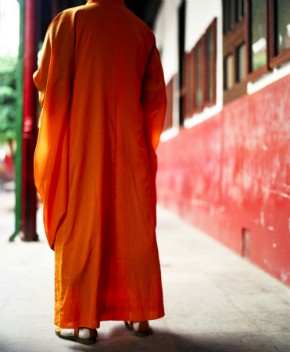The militant Buddhists

American Christians tend to view other faiths through the lenses of stereotypes. Islam is often deeply suspect, while Buddhism and Hinduism are usually viewed with respect, even affection. Little controversy arose when Lisa Simpson converted to Buddhism—imagine the outcry if she had accepted Islam.
Such favorable attitudes mean that Western media treat Asian faiths quite generously in matters of scandal and religious conflict. Christian believers on the ground in Asian countries, though, face issues of pressing concern, even of survival.
Earlier this year, Pope Francis made heroic efforts to reach out to the Buddhist majority of Sri Lanka, a land where Christians and Buddhists have long engaged in fruitful intellectual exchange. Still venerated is theologian Lynn de Silva, a great Methodist pioneer of dialogue.
Read our latest issue or browse back issues.
But relations are less harmonious below the level of prelates and scholars. Religion in Sri Lanka has long been bound up with ideas of ethnic and racial identity, with a very powerful order of monks, the Sangha, as enforcers of purity against all outsiders. It is no exaggeration to compare the modern-day monks in such lands with the turbulent and spectacularly violent Christian monks of late antiquity.
Only in 2009 did Sri Lanka end its decades-long ethnic civil war, which inevitably left many unresolved grievances. Today, Buddhist monks and lay organizations repeatedly attack minority communities, including Christians, who constitute some 6 percent of the population. Although extremist groups chiefly target Muslims and Hindus, dozens of churches have been destroyed and vandalized in recent years, especially those belonging to newer and expanding evangelical denominations. Monks personally lead and direct mobs, often with sympathy and tacit support from government and law enforcement officials.
Christian critics of militant movements in Sri Lanka describe their enemies as the “Buddhist Taliban,” and the analogy is not farfetched. The hard edge of militancy is the powerful and aggressive Bodu Bala Sena organization.
Anyone familiar with Buddhist teachings of nonviolence and nonattachment might find a certain irony in the translated title of this movement, the “Buddhist Power Force,” or Buddhist Brigade. Monks also lead the xenophobic National Heritage Party, the JHU, which seeks laws prohibiting Christian conversions. Inspiring their campaign was the suicidal immolation by fire of a Buddhist monk in protest against Christian strength in the island, and the presence of missionaries. Beyond the conversion issue, militants demand the full integration of Buddhist principles into Sri Lankan law and public policy.
Buddhist persecution is if anything still uglier in Myanmar, the former Burma. As in other nations, Buddhism here is intimately associated with ethnic identity and national loyalty, and at least some Buddhist clergy adopt the role of superpatriotic vigilantes. One very influential monk is Ashin Wirathu, an anti-Muslim demagogue who spreads his message through social media. Seemingly without irony, he describes himself as the Burmese bin Laden.
One target of persecution in Myanmar is the Muslim Rohingya people, who offend purists on the grounds of both their faith and their nationality. Western observers have been shocked to see saffron-robed monks as the leaders and main perpetrators of persecution.
Christians, too, suffer this double disability, in that so many belong to minority peoples like the Karen. (Myanmar’s Christians probably make up 5 percent of the population; exact numbers are hazy.) They are multiply victimized by state agencies and Buddhist militants, with many reports of kidnapping, abduction, and sexual violence. The situation is not too different from the much better reported plight of minorities in Muslim Pakistan.
Thankfully, the religious tensions in these two countries are not replicated across the vast Buddhist world. Still, militancy could become more commonplace if Christian conversions grow in other lands where Buddhist elites presently have less need to fear an outside threat. Already in Thailand, Buddhist monks have been prominent in the struggle against Islamic rebels. The rights of Christians and members of other minority faiths are also strictly constrained in the Buddhist state of Bhutan.
Contemplating Buddhist intolerance and extremism, observers could easily fall into two equally perilous traps. One would be to condemn Buddhism as such and to see it as a primitive or fanatical faith that just happens to have achieved a favorable image in the gullible West. Any acquaintance with the incredible riches of Buddhist spirituality should prevent such a conclusion.
But it would be just as wrong to explain away these trends as a freakish departure from authentic Buddhism, the work of “monks behaving badly.” Buddhists in many cultures have allied themselves with reactionary or repressive regimes, and the faith has an ancient military tradition.
The worst we can say of Buddhism is that, like other religions, its adherents are flawed human beings who sometimes use unacceptable means to defend what they believe to be the truths of their faith. Much like Christians, in fact.







